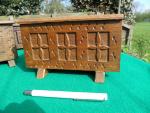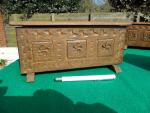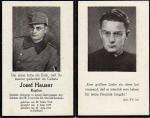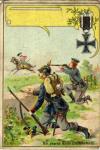-
Posts
2,143 -
Joined
-
Last visited
-
Days Won
10
Content Type
Profiles
Forums
Blogs
Gallery
Events
Store
Everything posted by Odulf
-
Wooden cult artifacts from the Third Reich. The Nazis captured many Germanic symbols and customs and incorporated these, obviously at random, in their New Order cult. For the modern collector, students and scolars of Third Reich artifacts it is difficult to distinguish old from new, in casu to separate pre 1945 from post 1945, let alone older items that were not tarnished by the third Reich. Since 1945 a great number of Germanic wooden relics have been produced, and as nearly none of these were dated by their producers is almost impossible to distinguish “old” from “new”. This field of interest has not yet been widely affected by forgers, but that is only a matter of time I think. Through the Internet and auction sites it is easy to slip pieces into circulation by advertising these as “Dachbodenfund” of “Erbestück”. Some pieces are incorrupted, other are dodgy, so Caveat emptor! The eager buyer may thus be deceived. In the true Germanic household (sic!), it became fashionable to erect some kind of family altar, almost in Roman fashion, preferably on an old historical (family) piece of wooden furniture. This could be a buffet, a simple narrow table, but also a newly produced “Stollentruhe” (a chest according to Medieval design). Over this (covering the surface of hanging on the wall) an embroidered cloth with a tree motive and/or runes or other symbols could be displayed. This altar would be furnished with (historically designed) candlesticks from bronze, iron, clay or wood, books (Mein Kampf, or other dogmatic lectures). Sometimes these would carry as many candles as there were family members; the candles to be lit on birthdays (Geburtstagsfeier), Christmas (Weihnachts- or Julfeier), New Year (Neujahrsfeier), Easter (Ostara) etc. And also for mourning a family member perished. Any family celebration was a reason for turning to the altar. Letters from the front, photos of family members, dead or alive, were placed up or around the altar; this was meant to be the center of homely celebration. Thus incorporating the dead and the living in a central family place of worship. Wooden (bread) plates also were placed on the altar. These originally handcrafted plates were presented to families at Christmas, weddings, births, and other highlights; mainly filled with bread, fruits, sausages or dried hams and other (home made) edible products. Also during the war this custom prolonged, wooden or earthen wear plates (specially designed for a unit) were presented by a unit’s HQ to the platoons, or otherwise by the men as a token of respect to their commanding officer. Some earthenware plates were produced in large quantities (to issue to the units) but I have also seen similar plates in metal (enameled, cast and hammered) in any size. Most of these were named to specific local units, such as “Flak”, “Pioniere”, “Bodenständige” or “Besatzungs”, “Marine-Werft”, “RAD” and other units, either in Germany or in the occupied countries. Such preparations took time, and on the front this would not have been very practical. Also, miniature wooden chests were placed on the altars. These were miniatures of the historical “Stollentruhe”, mostly from oak, and these contained the artifacts of the family. Such as broaches, assembly pins, and other badges to be kept but not worn permanently. It was a simple performance of the family treasury, naturally containing Party trinkets. For treasured (party) documents, other chests were produced, wide enough to contain rolled-up pieces of paper such as award documents, promotions, and special awards. Thus, the family altar was supposed to be the central point of gathering in any Germanic household, but I doubt if these intentions received a general appreciation. The artifacts may have been bought by others than the dedicated followers of the New Order, but to my understanding this was not the fact. Not even all “Partei Mitglieder” followed this proclaimed this fashion, mainly due to finances. Party membership did not include the funds to furnish such extravagancy. So it became a fashion, more or less, or as far as the purse allowed. This practice makes these altar pieces not common, but also not rare. Many of the wooden artifacts were burned, during the denazification. Especially in Southern Germany, many have survived because the Allied Troops did not take offence from indefinable wooden plates amongst the many they found in a Bavarian homestead or such like house. That is the main reason why many of these plates have survived. But each of these was crafted by a skilled craftsman, and thus they are unique in their right. And in other respect they are the continuation of an ancient German(ic) custom. It takes a “nose” to define post 1945 wooden arifacts from earlier specimen. But to define, it is a matter of experience and “fingerspitzengefühl”. I am not concerned with this matter, and I do not consider myself an expert on age, I am only interested in the custom and the symbolism and in my collection I have examples of all times. To collectors I can only say that all pre 1945 plates I have noticed, were made from oak, excluding all other woods, but (!), I dare not say (exclusively) that other sorts of wood were not used. This is not a science! This has to do with history, circumstances and possibilities. Many collectors are in search for facts; well, these I cannot give.
-

English Soldier with Medals Photo?
Odulf replied to Wachtmeister's topic in Great Britain: Research, Documentation & History
The photo should date post about 1920 (by that time all WW1 medals were distributed), but are you sure it is a CdV because that size was nearly out of fashion by that time. I agree that he made a dog's dinner of his medal bar. Can you please show the whole photo? -

EK 1914 The simple WW1 EK2...
Odulf replied to Chris Boonzaier's topic in Germany: All Eras: The Iron Cross
-

EK 1914 The simple WW1 EK2...
Odulf replied to Chris Boonzaier's topic in Germany: All Eras: The Iron Cross
-

EK 1914 The simple WW1 EK2...
Odulf replied to Chris Boonzaier's topic in Germany: All Eras: The Iron Cross
-
I have received and read this very comprehensive and accessible and almost complete monography with great interest. It filled a gap in my library and I am grateful that Demir took it upon him to examine this decoration and share his knowledge with the world wide community. However, I have been looking for the numbers of awards made (to Turkish recipients, to Germans and others) because that puts a medal or decoration into perspective. The book also refers to the Imtiyaz and Liyakat Medals, which gives it an extra dimension; this chapter tingles my appetite for more information, like numbers issued, variations, sizes, awards to non-Ottoman recipients, etc. (perhaps another project?). As a writer about medals and military subjects I realize that nothing is perfect, but striving for perfection kills the publication of final output, because 100% is impossible. Once closed, new and other interesting facts appear, but the author has a final. Therefore Demir, I hope that this success will encourage you to exhibit more information about the Ottoman medals and decorations, I want it all! Carry on Demir!
-
11th Hussars were nicknamed Cherry Pickers because during the Wellington campaign in the Penninsular War they were riding past a cherry orchard, dismounted to gain extra rations and were attacked and descimated by French cavalry (the British like to celebrate their less succesful moments).
-

India General Service Medal (IGS)
Odulf replied to Herman's topic in Great Britain: Orders, Gallantry, Campaign Medals
Obviously he was a British NCO and his rank was Colour Sergeant. Is the medal named in block capitals or in running schript? -
Are you sure that it is the later King Edward VII? Edward was quite an elderly man when he became king. To my opinion, this is the later King George V, who was also named Prince of Wales before his coronation in 1910. He gained the title Pince of Wales when his father Edward VIII was crowned in 1902. The King of Spain is Alfonso XIII (1886-1941), who became king (in name) at birth (Infant King) and assumed Head of State in 1902. see also: http://william-silvester.suite101.com/king-alfonso-xiii-a82132
-

Belgium WW1 Cap Badge - or, Souvenir ?
Odulf replied to Mervyn Mitton's topic in Northern European & Baltic States
Here is a link to show you the brass Dutch Royal Marines Anchor. http://www.nederlandsemilitaria.com/viewtopic.php?f=30&t=1247 -

Belgium WW1 Cap Badge - or, Souvenir ?
Odulf replied to Mervyn Mitton's topic in Northern European & Baltic States
To my opinion it is not Dutch. Dutch anchors wear a similar crown, but the brass RNLN crowns (worn only by the Marines) are all plain, where as this anchor has a "rough" surface. Also the pin broach is not Dutch, Dutch anchors are fastened to the shoulderloops and vizor cap by 2 brass lugs. Dutch, Belgian and Danish crowns are very similar. -

What is a fair price for a different variety of US medals?
Odulf replied to MCPJSmits's topic in United States of America
Hi Michael, You could try to place your pics on an external photo hosting site like Photo Bucket and publish the link on this forum. Another possibility is reducing the size (with MS Paint) and try again. Best of luck! -
The original picture was painted by the famous Dutch painter of portraits Pieneman, it is in the collection of the Rijksmuseum in Amsterdam (National Art Gallery). Janssens was Governor of the Dutch Cape Province (before the British "salvaged" the colony) and he was General of the Dutch Army in the Dutch East Indies (Indonesia). see also: http://www.rijksmuseum.nl/collectie/zoeken/asset.jsp?id=SK-A-2219&lang=nl
-
This is not a French general, quite the opposite, it is the Dutch General of Infantry Jan Willem Janssens (1762-1838), first Chancellor and Grand-Cross of the Military Order of William (1815), but he was also decorated with the Grand-Cross of the French Legion of Honour. But it is a strange picture, because the sash of the Order should be worn over the right shoulder, so I suppose that the image was mirrored as the GC-LoH should be worn on the right breast instead otherwise.
-
SS-Sturmbannführer Ullenberger No further information, he signed many provisional Croat award documents to Security Police and SS Volunteer Police (Volksdeutsche Gendarmerie) in the Zagreb region in Yugoslvia.
-
Rangliste / Dienstalterliste 1918 (nach dem Stande vom 14. Februar 1918): S.92 Heinrich - Fähnrich z.S. Diensteintritt 4.7.16; Datum des Patents K.O. 26.4.17 ern. S.96 Fritz - Fähnrich z.S. Diensteintritt 2.1.17; Datum des Patents K.O. 16.11.17 ern. No officers of this name are mentioned in the Rangliste der Deutschen Reichsmarine (nach dem Stande vom 1. November 1924).












